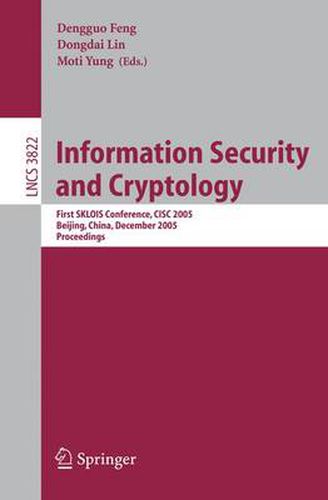Readings Newsletter
Become a Readings Member to make your shopping experience even easier.
Sign in or sign up for free!
You’re not far away from qualifying for FREE standard shipping within Australia
You’ve qualified for FREE standard shipping within Australia
The cart is loading…






This title is printed to order. This book may have been self-published. If so, we cannot guarantee the quality of the content. In the main most books will have gone through the editing process however some may not. We therefore suggest that you be aware of this before ordering this book. If in doubt check either the author or publisher’s details as we are unable to accept any returns unless they are faulty. Please contact us if you have any questions.
The ?rst SKLOIS Conference on Information Security and Cryptography(CISC 2005) was organized by the State Key Laboratory of Information Security of the Chinese Academy of Sciences. It was held in Beijing, China, December 15-17,2005andwassponsoredbytheInstituteofSoftware,theChineseAcademy of Sciences, the Graduate School of the Chinese Academy of Sciences and the National Science Foundation of China. The conference proceedings, represe- ing invited and contributed papers, are published in this volume of Springer’s Lecture Notes in Computer Science (LNCS) series. The area of research covered by CISC has been gaining importance in recent years, and a lot of fundamental, experimental and applied work has been done, advancing the state of the art. The program of CISC 2005 covered numerous ?elds of research within the general scope of the conference. The International Program Committee of the conference received a total of 196 submissions (from 21 countries). Thirty-three submissions were selected for presentation as regular papers and are part of this volume. In addition to this track, the conference also hosted a short-paper track of 32 presentations that were carefully selected as well. All submissions were reviewed by experts in the relevant areas and based on their ranking and strict selection criteria the papers were selected for the various tracks. We note that stricter criteria were applied to papers co-authored by program committee members. We further note that, obviously, no member took part in in?uencing the ranking of his or her own submissions.
$9.00 standard shipping within Australia
FREE standard shipping within Australia for orders over $100.00
Express & International shipping calculated at checkout
This title is printed to order. This book may have been self-published. If so, we cannot guarantee the quality of the content. In the main most books will have gone through the editing process however some may not. We therefore suggest that you be aware of this before ordering this book. If in doubt check either the author or publisher’s details as we are unable to accept any returns unless they are faulty. Please contact us if you have any questions.
The ?rst SKLOIS Conference on Information Security and Cryptography(CISC 2005) was organized by the State Key Laboratory of Information Security of the Chinese Academy of Sciences. It was held in Beijing, China, December 15-17,2005andwassponsoredbytheInstituteofSoftware,theChineseAcademy of Sciences, the Graduate School of the Chinese Academy of Sciences and the National Science Foundation of China. The conference proceedings, represe- ing invited and contributed papers, are published in this volume of Springer’s Lecture Notes in Computer Science (LNCS) series. The area of research covered by CISC has been gaining importance in recent years, and a lot of fundamental, experimental and applied work has been done, advancing the state of the art. The program of CISC 2005 covered numerous ?elds of research within the general scope of the conference. The International Program Committee of the conference received a total of 196 submissions (from 21 countries). Thirty-three submissions were selected for presentation as regular papers and are part of this volume. In addition to this track, the conference also hosted a short-paper track of 32 presentations that were carefully selected as well. All submissions were reviewed by experts in the relevant areas and based on their ranking and strict selection criteria the papers were selected for the various tracks. We note that stricter criteria were applied to papers co-authored by program committee members. We further note that, obviously, no member took part in in?uencing the ranking of his or her own submissions.